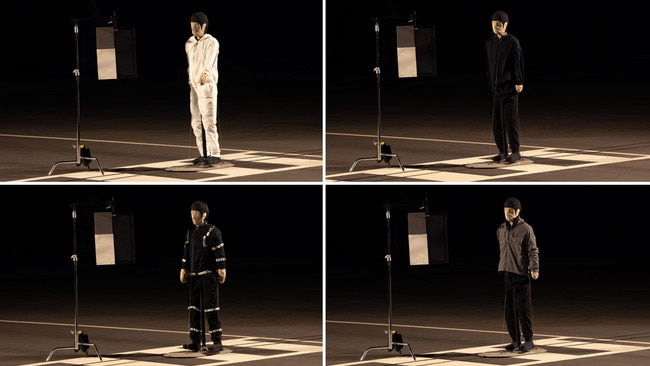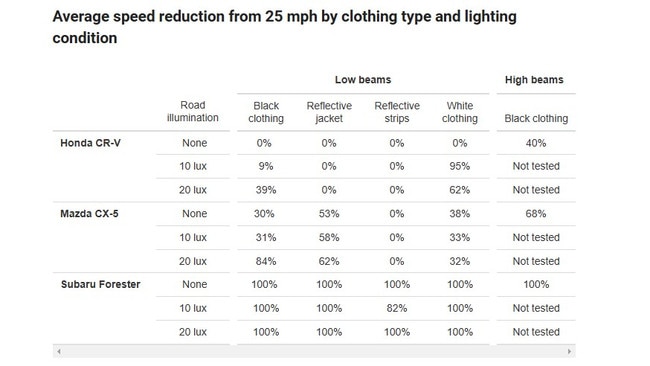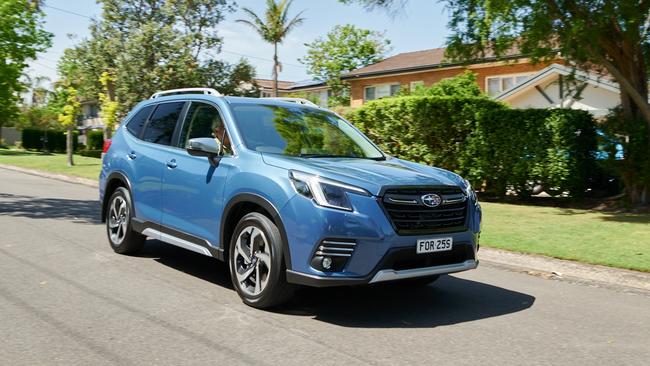High-visibility clothes may hinder pedestrian crash prevention sensors
A piece of safety technology common in all new cars has been called out after a major fault was discovered.

Motoring News
Don't miss out on the headlines from Motoring News. Followed categories will be added to My News.
High-vis clothing that stands out to humans may be invisible to the latest cars.
A study conducted by the Insurance Institute for Highway Safety (IIHS) in the US suggests high-visibility clothes people wear to stand out could make them nearly impossible for crash avoidance technology to recognise.
David Harkey, president of the IIHS, says “it’s untenable that the clothes that pedestrians, cyclists and roadway workers wear to be safe may make them harder for crash avoidance technology to recognise”.

The safety body tested crash avoidance systems in three cars and found that they struggled to stop for pedestrians wearing clothes with reflective high-visibility tape.
Previous IIHS research has shown pedestrian detecton techology in cars with automatic emergency braking (AEB) dramatically reduces the liklihood of a crash.
The non-profit organisation examined the effects of “conspicuous” clothing and various roadway lighting on the performance of pedestrian AEB systems in three cars, the Honda CR-V, Mazda CX-5 and Subaru Forester.
MORE: Wild car tech on show at CES

Multiple trials were conducted with a dummy dressed in various clothes, including clothing with reflective panels.
The tests were run at 40 km/h in three different roadway lighting scenarios.
MORE: Annoying car tech to be tested in the real world

The Honda CR-V and Mazda CX-5 hit the dummy in most of the tests conducted, while the Subaru Forester came to a complete stop without hitting the pedestrian dummy in all but one trial, according to the researchers.
When the dummy was dressed in black, both the Honda and Mazda slowed substantially when using their high-beams with no road illumination.
MORE:Drivers warned not to trust new car tech

In the same lighting conditions, but using low-beam lights, the CR-V failed to slow at all, while the CX-5 reduced its speed by less than one-third.
When the pedestrian dummy was clothed with reflective clothing both the vehicles’ safety systems began to struggle significantly.
When the dummy was clothed with reflective strips, both the Honda and Mazda failed to slow in all lighting scenarios.

The IIHS said “it’s not clear why the Honda and Mazda systems struggled with the reflective strips or how many other systems might have trouble identifying pedestrians wearing this type of clothing”.
“However, the lapse is a concern, considering the number of roadway workers and emergency personnel who use similar garments to mitigate risk when they’re working on the road.”
Researchers for the study noted automakers are working to address the issues in response to the latest results.
The Subaru Forester performed substantially better than the other two vehicles.
The SUV came to a complete stop without hitting the pedestrian dummy in every trial except one run in which the dummy was wearing clothing with reflective strips with lighting condition illuminated at 10 lux.
Even in that test, it slowed by “more than 80 per cent”.

The safety group suggests further research is needed to fully understand how the crash avoidance systems respond to people wearing High-visibility clothing while on roads with the IIHS president David Harkey describing the findings as a “worrisome blind spot”.
“These results suggest that some automakers need to tweak their pedestrian automatic emergency braking systems,” Mr Harkey said.
Originally published as High-visibility clothes may hinder pedestrian crash prevention sensors



